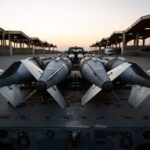
The Close-In Weapon System (CIWS) is advanced defense equipment safeguarding allied ships from imminent threats like enemy anti-ship missiles, aircraft, and high-speed attack boats. As the last layer of defense, it kicks in when other systems, such as surface-to-air missiles (SAAM) and naval guns, fail to neutralize the danger.
The CIWS is tasked with intercepting the final threats that breach a ship’s air defense. Like a soccer goalkeeper defending the goal after the defense has broken down, the system provides a critical second chance to stop enemy missiles or aircraft. It’s also highly effective against smaller targets like fast patrol boats or terrorist speedboats that manage to get dangerously close.
Evolution and Types of CIWS Systems
Earlier systems relied on manual targeting and firing, but the CIWS, with its radar and computer analytics, has revolutionized engagement accuracy. Despite these advancements, even the most advanced systems face challenges when dealing with missiles and aircraft performing evasive maneuvers at extreme speeds.
The latest CIWS model operates with full automation, using integrated radar and computing systems to track and engage enemy threats without human intervention. These systems fall into three broad categories: gun-based, missile-based, and hybrid gun/missile platforms.
Gun-Based CIWS: Phalanx and Goalkeeper Systems
Gun-based CIWS options typically include weapons like the Gatling gun, revolver cannon, and chain gun. The South Korean Navy’s primary systems are Raytheon’s Phalanx and Thales’ Goalkeeper, both known for their effectiveness in high-threat environments.
Gun-based systems typically include Gatling, revolver cannon, and chain guns. The two primary CIWS systems the South Korean Navy uses are the Phalanx, produced by the American company Raytheon, and the Goalkeeper, developed by the Dutch company Thales (formerly Signaal).
The South Korean Navy relies on the gun-based Phalanx and Goalkeeper systems. The Phalanx, equipped with a 20mm M61A1 Gatling gun, has a shorter effective range of 1.49 kilometers. However, the system has been upgraded with Block 1B ammunition to boost both accuracy and lethality. Furthermore, enhanced optical tracking and a slightly longer barrel further close the performance gap with the Goalkeeper.
Smaller in size and with an integrated radar and ammo feed, the Phalanx can be mounted directly on the ship’s deck, costing roughly half as much as the Goalkeeper. Recently, a ground-based version of the Phalanx has been introduced. The C-RAM (Counter Rocket, Artillery, and Mortar) system, which intercepts insurgent-fired mortars in Iraq, is based on this platform and specializes in intercepting various projectiles.
Conversely, the Goalkeeper uses the powerful GAU-8 30mm seven-barrel rotary cannon, with an effective range of 2 kilometers. While bulkier and requiring more space below deck, it delivers high single-shot lethality and is about twice as expensive as the Phalanx.
South Korea’s Navy installed the SGE-30 Goalkeeper aboard its Sejong, the Great-class destroyer, but later integrated the Phalanx. However, with the Goalkeeper nearing the end of its production run, the Navy plans to introduce a domestically-produced CIWS under the CIWS-II project for future ships.

Missile-Based CIWS and Technological Advancements
Missile-based CIWS systems offer an alternative to gun-based defenses, which are limited in range and can engage multiple targets simultaneously. Germany initiated a missile-based CIWS project, later joined by the U.S., and together, they worked with Raytheon to develop the system. Although technological challenges hindered early efforts, the first operational system, the RIM-116A Block 0, was introduced in 1992.
This system uses radar emission tracking and a rotating launcher to intercept incoming threats. By the 2000s, an upgraded version, the RIM-116B Block 1, was released, featuring infrared (IR) imaging guidance. This enhancement allowed the system to detect and engage objects that do not emit radar signals, extending its capabilities with a range of up to 9 kilometers.
South Korea has equipped its Sejong the Great-class destroyers, Chungmugong Yi Sun-sin-class destroyers, Incheon-class frigates, and Dokdo-class amphibious assault ships with the RIM-116 Block 1. With the RIM-116B Block 2, these systems have been further upgraded to counter the latest high-speed anti-ship missiles.
Gun-based CIWS systems, like the 76mm naval gun developed by Italy’s Oto Melara, also play a role in maritime defense. The Italian Navy typically employs the Oto Breda 40mm twin-barrel and the Oto Melara 76mm Compact or Super Rapid systems for long-range engagements. However, these guns are not standalone systems but are integrated into the ship’s overall combat system for coordinated defense.
Innovations in CIWS: Laser and Next-Gen Technologies
Reports indicate that the U.S. Navy is advancing a laser-based CIWS system. The AN/SEQ-3 laser weapon system (LaWS), tested aboard USS Ponce in 2013, is being developed as a purely CIWS-focused solution. Unlike traditional systems, LaWS is not intended to intercept missiles or engage large aircraft or submarines. Instead, it uses high-powered lasers for destruction and low-powered beams for warning purposes.

Next-Gen Technologies: AESA Radar and EOTS
In 2021, military authorities chose LIG Nex1 to spearhead the development of South Korea’s next-generation Close-In Weapon System (CIWS-II) for naval ships. The project, valued at 320 billion won (around $238 million), is set to deliver an advanced composite weapon system incorporating shooting control, Active Electronically Scanned Array (AESA) radar, and Electro-Optical Tracking Systems (EOTS). The development is expected to be completed by 2030.
The domestically-produced CIWS-II will first be installed on the Ulsan-class Batch-III frigate, which is currently undergoing testing. Future Korean naval vessels, such as the KDDX (Korean Destroyer eXperimental) and FFX-III (next-generation frigates), are also slated to receive the CIWS-II.
The latest CIWS-II model features the AESA radar, a pivotal technology that offers quicker detection and tracking of incoming threats than traditional mechanical radar. This advancement is crucial for defending against the hypersonic missiles being developed worldwide.
Another key technology, EOTS, has evolved from merely confirming targets to acting as a supplementary sensor for radar. This improvement enables more precise target tracking, significantly enhancing engagement accuracy.
A robust fire control system is also essential for CIWS-II, as it needs to calculate ballistics swiftly and precisely to counter missiles and fast-moving surface targets. The ability to adjust these calculations in real time is critical, especially when dealing with hypersonic threats that are highly likely to hit their targets unless intercepted in time.
Moreover, system integration capabilities will ensure seamless communication between the ship’s sensors, weapons, and other defense systems. Modern naval vessels rely on stealth technologies, such as radar-absorbing coatings, to enhance survivability, making reduced radar signatures an important feature of the CIWS-II system.














Most Commented